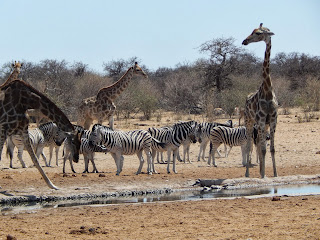To watch my report on Namibia, click here, and go to 12/12 show. My segment runs from 35 minutes in until the end of the show.
Loyal listeners and readers know this has been quite a year of long-distance train travel for me. In the spring, I had a great adventure on the Trans-Siberian Railroad. In October, I headed off to Africa to journey on The Desert Express, a little-known upscale train that travels around Namibia.
First, a little geography lesson. Namibia is located in the southwest of Africa. If there is such a thing as a typical sub-Saharan African country (and there's not), this is not it. Yes, there is wildlife, including elephants and giraffe and lions, but what distinguishes the country is the Great Namib Desert, dating back 55 million years. The oldest desert in the world also contains some of the world's highest sand dunes.
There are no non-stops flights from the United States to Namibia. The "easiest" ways to get there:
1.You can travel direct from New York or Washington, DC into Johannesburg on South African Airways and then hop the short flight to Windhoek or
2. Fly to Frankfurt and transfer to Air Namibia.
Either way, you are talking more than 20 hours in flight (from the East Coast), but that's the price you pay for a unique travel experience.


For 11 days, I wandered the country on the
Desert Express. The Namibian-German-engineered train, circa 1998, is a marvel of clever design. The train contains four sleeping cars, a lounge car, and a dining car. Each of the sleeping wagons is nature-themed--there's Springbok, Oryx, Kokerboom (Quiver Tree) and Meerkat. Unlike the Trans-Siberian, which contained separate classes of compartments, the Desert Express offers all guests the same experience, including the pleasure of a bathroom en suite.
Speaking of which, you have never seen a more efficient use of space, although I suppose anyone taller than 6 feet 2 or heavier than 160 pounds might disagree. The wee space (so to speak) has a toilet, a shower with a door that prevents water from spraying, and a magnificent rotating sink.
Other features of the interior design include rock sand paneling; extensive use of red golden woods; handmade amber-colored furnishings in the bar car; and comfortable seating areas in the compartments that convert into up to three beds at night.
The Desert Express belongs to Namibian TransNamib Holding Ltd. and is chartered by Lernidee.de for the long-distance trips. For those looking for a shorter ride, weekend trips are available between Windhoek and Swakopmund on the Atlantic coast. The one-way weekender, which includes stops at game lodges and the dunes, starts at $350 per person/double occupancy.
Loyal listeners and readers know this has been quite a year of long-distance train travel for me. In the spring, I had a great adventure on the Trans-Siberian Railroad. In October, I headed off to Africa to journey on The Desert Express, a little-known upscale train that travels around Namibia.
First, a little geography lesson. Namibia is located in the southwest of Africa. If there is such a thing as a typical sub-Saharan African country (and there's not), this is not it. Yes, there is wildlife, including elephants and giraffe and lions, but what distinguishes the country is the Great Namib Desert, dating back 55 million years. The oldest desert in the world also contains some of the world's highest sand dunes.
There are no non-stops flights from the United States to Namibia. The "easiest" ways to get there:
1.You can travel direct from New York or Washington, DC into Johannesburg on South African Airways and then hop the short flight to Windhoek or
2. Fly to Frankfurt and transfer to Air Namibia.
Either way, you are talking more than 20 hours in flight (from the East Coast), but that's the price you pay for a unique travel experience.


For 11 days, I wandered the country on the
Desert Express. The Namibian-German-engineered train, circa 1998, is a marvel of clever design. The train contains four sleeping cars, a lounge car, and a dining car. Each of the sleeping wagons is nature-themed--there's Springbok, Oryx, Kokerboom (Quiver Tree) and Meerkat. Unlike the Trans-Siberian, which contained separate classes of compartments, the Desert Express offers all guests the same experience, including the pleasure of a bathroom en suite.
 |
| Desert Express Bar Car |
Other features of the interior design include rock sand paneling; extensive use of red golden woods; handmade amber-colored furnishings in the bar car; and comfortable seating areas in the compartments that convert into up to three beds at night.
The Desert Express belongs to Namibian TransNamib Holding Ltd. and is chartered by Lernidee.de for the long-distance trips. For those looking for a shorter ride, weekend trips are available between Windhoek and Swakopmund on the Atlantic coast. The one-way weekender, which includes stops at game lodges and the dunes, starts at $350 per person/double occupancy.





























